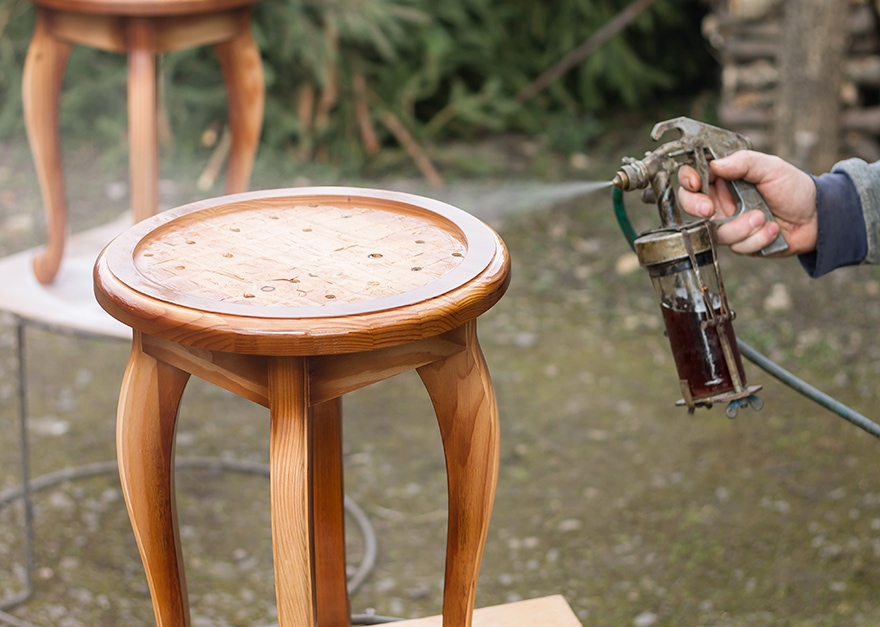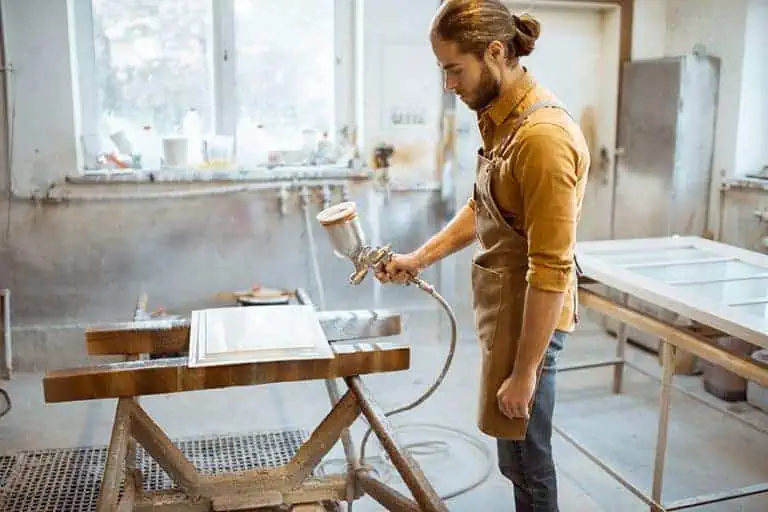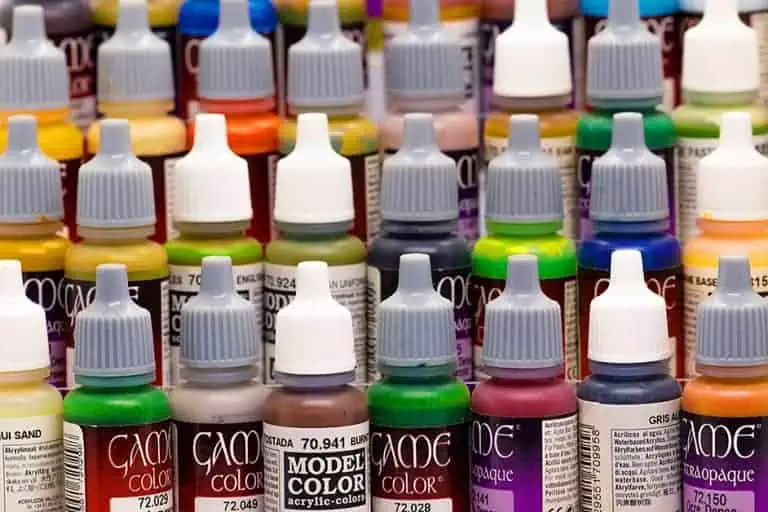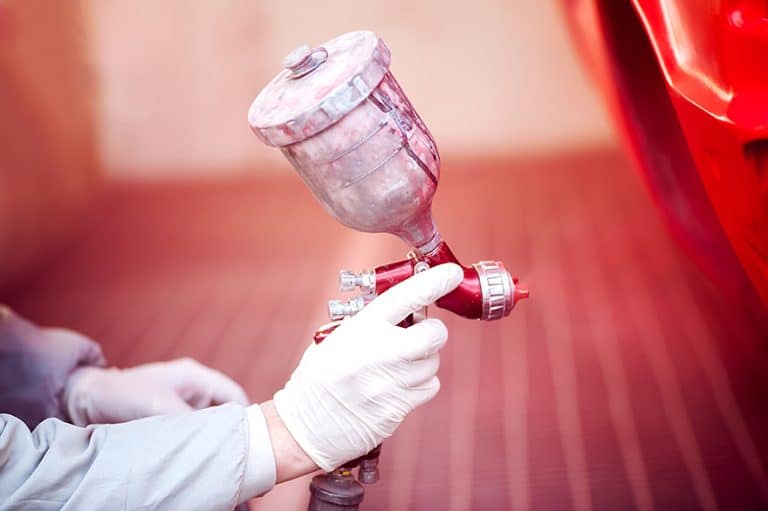How to Spray Paint Furniture – Achieve Perfect Results
This post may contain affiliate links. We may earn a small commission from purchases made through them, at no additional cost to you.
A furniture paint sprayer is a painting tool that has gained popularity over the years with both amateurs and professionals. The main benefits include completing a paint job faster with less effort and ending up with a smooth and professional finish. The problem is deciding on what the best paint sprayer for furniture is. There are so many options available, which is why we are here to help you figure out the best choice for you.
Table of Contents
- 1 Why Should you Consider Furniture Paint Spraying?
- 2 Types of Furniture Paint Sprayers
- 3 How to Find the Best HVLP Paint Sprayer for Furniture?
- 4 How to Operate a Paint Sprayer for Furniture
- 5 Furniture Paint Sprayer Tips
- 6 Frequently Asked Questions
- 6.1 What is Best, to use a Paint Sprayer or Brush?
- 6.2 Do you Need to Prepare Before Using a Paint Sprayer?
- 6.3 How do you Choose the Right tip for Your Paint Sprayer?
- 6.4 Is it Best to Spray Outside or Inside?
- 6.5 Is it Necessary to Practice Spray Painting?
- 6.6 Do you Need to Thin Your Paint Before Spraying?
Why Should you Consider Furniture Paint Spraying?
Paintbrushes can easily do the job of painting furniture, so why even consider a paint sprayer for furniture? Well, to begin with, paint sprayers can be taken anywhere and can be easily stored when not in use. You also do not have to choose the most expensive spray paint gun for furniture, as there are a variety of options available to you that can suit your budget and other requirements.
A furniture paint sprayer is well-known for providing even coverage and reaching hard-to-paint areas. Painting more detailed wood furniture pieces become a lot easier. Also, paint is not the only medium you spray. You should also be able to use a sprayer for stains, latex paints, and lacquer, adding to its versatility. The finish a paint sprayer provides is of excellent quality, something you cannot easily get by using a paintbrush or roller.
A spray paint gun for furniture will most definitely cost more than a paintbrush or roller, however, a paint sprayer can be used for many years and will likely be well worth the money in the long run. Even though paint sprayers may be more expensive than a roller or brush, prices have become more affordable over recent years. Before, professionals were the only ones doing furniture paint spraying, as it was too expensive. Today, you have more options and cheaper prices, for both the professional and the do-it-yourself enthusiast.
As mentioned, one of the main benefits of using a paint sprayer is the time saved doing the job. When using a paint sprayer for furniture, you can most probably finish a job five times faster than when using a roller or paintbrush.

The Pros and Cons of Furniture Paint Spraying
We have already mentioned some great benefits, lets us have a look at a few more pros. Unfortunately, it is not all easy going and there are also a few disadvantages you need to take into consideration. You need to look at all the possibilities so you can determine if using a furniture paint sprayer is for you.
PROS
- You can spray onto almost any surface including wood, metal, plastic, and more
- Paint that has been sprayed dries faster than when applied with a paintbrush
- Paint faster and get more projects finished
- Larger areas are covered more quickly
- Smooth finish with no brush marks
- Easier to cover more difficult to reach places and more detailed work
- Spraying requires less effort than when using a paintbrush
CONS
- More expensive than buying a paintbrush or roller
- If you work inside, you will have to cover other surfaces you do not want paint to get on as you spray
- Depending on what paint sprayer you use and your spray technique, you could land up using a lot more paint
- When using a paint sprayer, it takes a lot more preparation
- Paint sprayers can take some time and effort to clean up
- You will need to learn how to use and maintain the equipment properly
Types of Furniture Surfaces That can be Spray Painted
Once you have purchased your paint sprayer and mastered the perfect technique for spraying paint, you will want to start revamping anything you can find. We already know that wood furniture paint spraying is popular, but what other types of surfaces can you spray? Some surfaces, especially if it is non-porous, may require a primer and prep work.
- Ceramics: You can have fun with this, although these may require a bit of preparation before painting, like lightly sanding
- Metal: The same applies to metal surfaces, some sanding and primer is necessary for the spray paint to adhere more effectively
- Plastic
- Tin
- Glass
- Terra-cotta
- Concrete
- Canvas
- MDF (Medium Density Board)
- Laminate
- Fabric
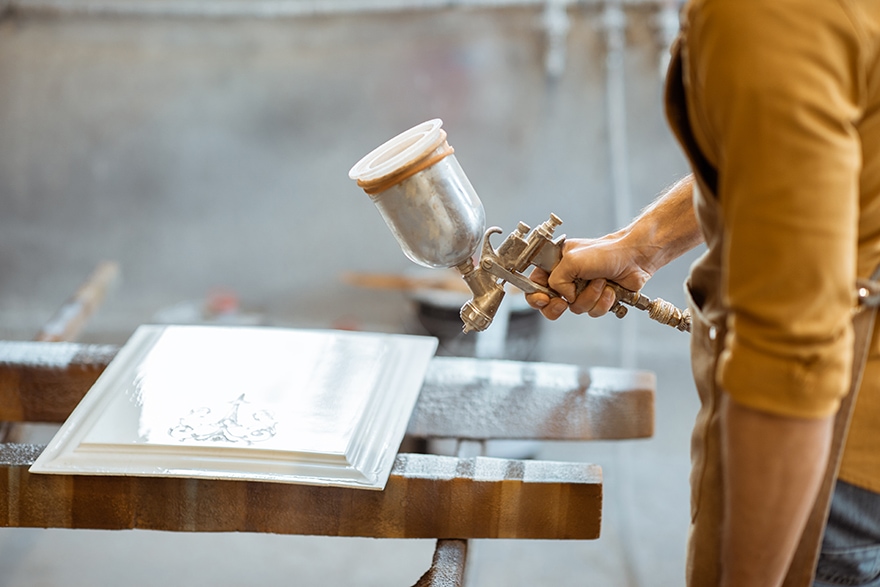
Types of Furniture Paint Sprayers
There are different types of furniture paint sprayer options, some are used more by professionals and can be expensive, such as the conventional compressed air paint sprayer. The gravity feed spray guns are used mostly in the automotive industry. The Low Volume Low Pressure (LVLP) sprayers are not widely available and are not as popular as other options, but they do still offer the least amount of overspray and are generally cheaper.
There is also the airless sprayer. This paint sprayer does not use air to pump the paint out, it pumps the paint out at high pressure through a small hole. Airless sprayers are great for large and flat surfaces and can be compared to using a roller. These are best used on exterior surfaces like fences or garage doors. These paint sprayers do tend to waste paint as some of the atomized paint is released into the air. This is also why you should tape or cover any areas you do not want the paint to get on. Sometimes, choosing a paint sprayer is a personal choice and depends on what you want to do. However, when it comes to popular options available, the following two come out above the rest.
High Volume Low-Pressure Paint Sprayer (HVLP)
The HVLP (High Volume Low Pressure) sprayers use a compressor or a turbine to atomizes the paint. These paint sprayers offer more precision, so are great for things like cabinets, doors, and handrails. The HVLP (High Volume Low Pressure) paint sprayers are easier to handle and waste less paint than an airless sprayer, although it still does produce significant overspray. They also offer a consistent and high-quality finish and are widely available. This spray system does tend to clog and does not work well with thicker or latex paints and the paint may need to be thinned. These are great as a paint sprayer for furniture and are easy to manage and maintain. You can adjust the spray rate and there are different nozzles available for different paints and spray patterns.
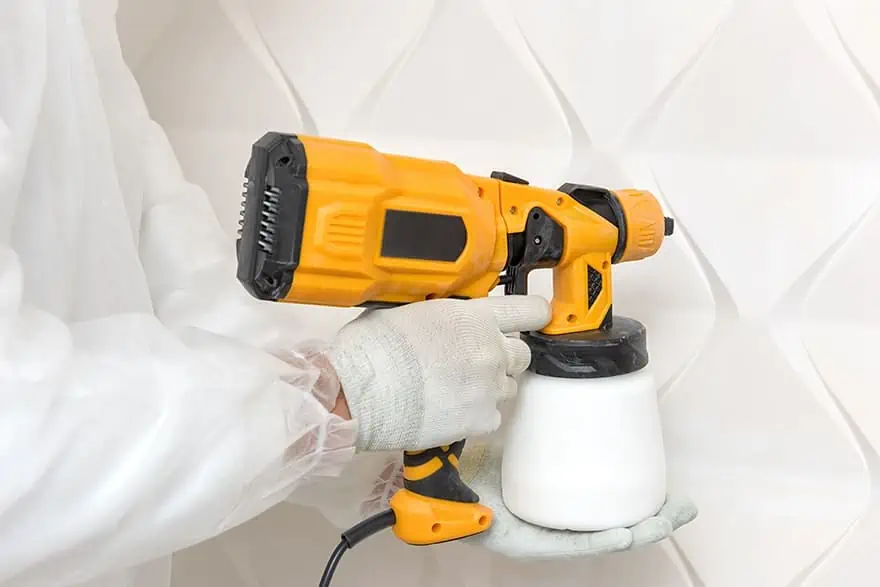
Handheld Sprayers
These may not be the first choice for professionals, but for the do-it-yourself enthusiast, the handheld paint sprayer could be a good idea if it suits your purpose. They are easy to use and are a popular choice amongst many. The handheld sprayers usually have a built-in turbine or airless system. Therefore, you do not have any hoses, or external compressors, or a turbine to worry about. There is a reservoir cup that holds the paint attached to the spray gun and the whole thing is powered by a battery. All you have to do is plug it in. The handheld sprayer is great to use on furniture as well as other surfaces. Larger areas are not advisable, as there is only so much paint it can hold at a time.
How to Find the Best HVLP Paint Sprayer for Furniture?
Choosing the best paint sprayer all depends on what you want to achieve and how much you are willing to spend. If you are a hobbyist, you might be looking for something that provides quality but is not too expensive. Have a look at various products online and read the reviews to get an idea of what is more popular and has a good track record. Below are a few pointers to help you find the best HVLP sprayer for furniture.
Paint Sprayer Power
Before going out to purchase a paint sprayer, you need to figure out how much pressure you need for your particular project. You can then look for a sprayer that has enough power to deliver what you need. High-pressure guns are faster and will cover larger areas more easily. However, if you are painting furniture, many prefer using the HVLP (High Volume Low Pressure) sprayer, it might be slower but there is less overspray, less mess and it offers more precision.
Paint Sprayer Tips or Nozzles
The spray tip or nozzle is an important part of the sprayer, the size will determine what you can spray. Smaller tips mean thinner materials and larger nozzles can handle thicker liquids. For example, stains and lacquers are thinner, therefore, require a smaller opening, while primers need bigger tips. If you choose a tip or nozzle that is too small, you run the risk of clogging and too big, there is the problem of overspray.
How Much can the Sprayer Hold?
The airless sprayer draws paint directly from your paint container, so offers a higher capacity for covering a larger area. The HVLP (High Volume Low Pressure) option comes with either a plastic or a metal cup or container that holds the paint. This cup can fit at the bottom of the spray gun or the top. Either way, these cups only hold so much paint and you will eventually have to refill. For smaller jobs, this should be no problem.

Weight and Ease of use
You will need to consider the weight if you want to work with the paint sprayer often. You want the process to be as easy and comfortable as possible. Although, smaller and lighter options will most likely have smaller paint containers that will need refilling more often. You might also want to consider the pros and cons of the handheld electric models versus those using a compressor or turbine. The question always comes down to what you are going to be using the paint sprayer for?
Flow Control
Not all paint sprayers have this feature, so look out for a sprayer that can adjust the flow when needed. For example, some areas on a piece of furniture are large and flat and can do with a little more paint. However, more delicate areas require more precision and a reduced flow of paint.
Versatility
Check to see if the paint sprayer you choose can handle a variety of materials, not only paint. This way, you will be getting added benefits. Some can manage anything from chalk paint to primer and varnish.
Cleaning Made Easy
Cleaning a paint sprayer can be quite a messy job. Also, it is an important step to keep your sprayer working for longer and prevents unnecessary repairs. Some sprayers come with an adaptor that you can attach to a hose pipe and clean. Others also provide cleaning supplies like brushes to help with the cleaning process. It is never a good idea to wait or skip cleaning, as you do not want to damage your paint sprayer or fail at your paint project.
Hoses and Cords
Depending on what you want to do, you might want a longer cord to reach further without having to move any heavy equipment with you. Look for options that come with a long cord and hose for better maneuverability.
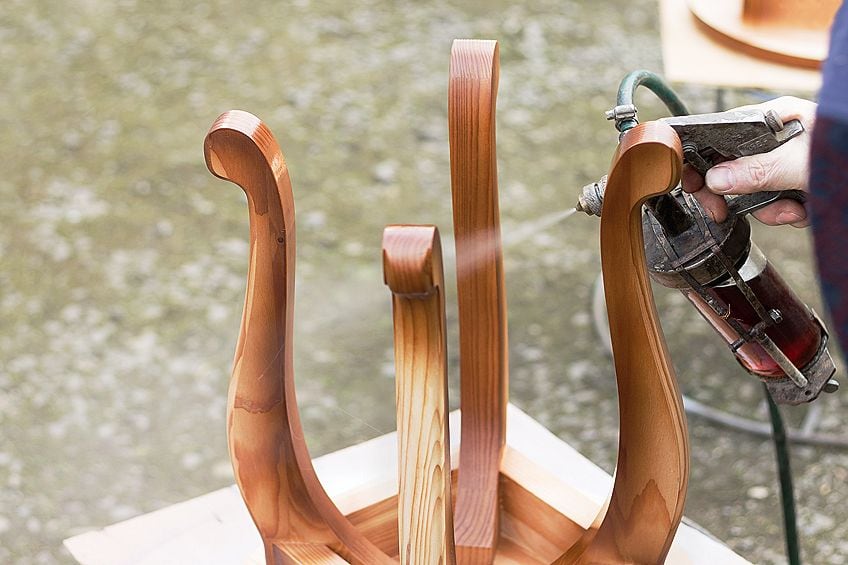
How to Operate a Paint Sprayer for Furniture
Whenever it comes to painting furniture or any surface, preparation is a vital stage. You will need to look over your piece of furniture to see if it needs any repairs. These need to be fixed before moving on to painting. For example, filling deep scratches. You can then clean the surface and remove any dirt or grease. Also, removing any hardware or drawers will help with creating a better paint job.
If the furniture item is in good shape, some light sanding should be sufficient. For any furniture item that already has a finish that is peeling away or looking worse for wear, it is best to remove it and start over with the bare wood. The next step is to apply a primer, which is not always necessary, however, if in doubt always go for it. You will find that some paint spray systems with a high-pressure system can spray on primer. Certain surfaces like metals also require a primer before painting. When it comes to using your paint sprayer, you should refer to the manufacturer’s manual for instructions.
Before you even purchase a spray gun, you would have already decided on what type of job, the type of paint you want to use, and selected the appropriate spray gun. Some paints are thicker and will need to be thinned before you can use them in a paint sprayer effectively.
Spraying outside would be preferable, as you need good ventilation when painting. However, if you are painting inside, you need to choose a well-ventilated space. You will also need to tape and cover any items or areas you do not want the paint to get on. You will also need the following safety gear:
- Eye protection
- Respirator mask
- Gloves
- Coveralls or at least long sleeves and pants
Whatever, spray gun you choose, make sure to familiarize yourself with all the spray gun settings and how the turbine or compressor works. In this case, we have chosen to go with an HVLP (High Volume Low Pressure) system. Before painting, it is a good idea to check the filters in your turbine or compressor to see if they need to be changed. Once ready, you can then plug it in and then attach the air hose.
When you fill the paint container, follow the paint manufacturer’s recommendations when it comes to thinning. Also, it is a good idea to strain the paint to prevent any dirt or other foreign materials from getting into the paint used for spraying. Check that the tip or nozzle is the correct one for your paint application. There are technical sheets for this, so you can find the best choice.
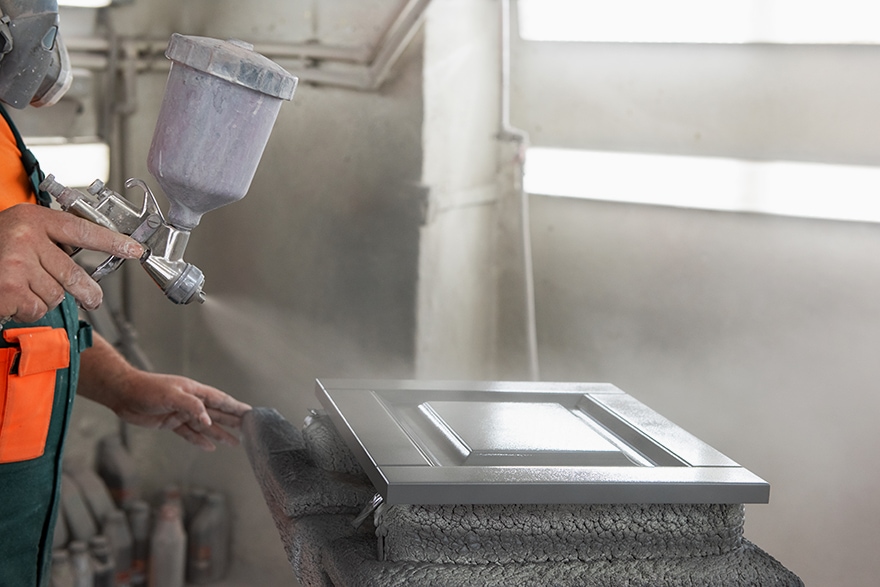
Next, connect the air hose to your paint gun and adjust the flow or air pressure. You can also adjust the fluid control setting, which allows more or less paint to come out. The fan control setting, which is usually located on the side, can also be adjusted. Make sure the check valve is fitted to pressurize the pot or paint container and is not leaking. This line helps prevent any material you are spraying from moving back up the air hose, which could then clog air passages inside the gun.
You can then adjust the fluid control knob which will give you the preferred atomization. You can choose to spray either vertically or horizontally by adjusting the air cap. Always test out your spray gun first by applying it to a scrap piece of wood. Hold the spray gun perpendicular to a surface to prevent uneven cover. Hold the spray gun about eight to twelve inches away from the surface and apply it in a consistent pattern.
To achieve a good finish, using the 50/50 technique is advised. Each line of a sprayed surface should cover or overlap at least 50 percent again on the following stroke. Try not to move only your wrist as you move, but rather your entire arm as you move along, and remember to keep the same distance. You might need to change the nozzle for spraying finer details.
Depending on the kind of paint you used, you can clean up using a solvent or water. Do not wait to clean your spray gun, rather do it straight away once you have finished painting. Fill the pot or container where the paint was held with the solvent or water and shake, then spray until it comes out clean. Make sure to remove all paint residue from your spray gun. You may have to remove the needle to make sure this is clean as well.
Furniture Paint Sprayer Tips
By now you will understand that using a paint sprayer is more than simply pointing and spraying. There are many factors to consider before jumping into the whole process. If you have decided to use a paint sprayer, here are some useful tips when it comes to furniture paint spraying.
- Always test or spray away from your piece to see if all the settings are correct and to make sure any dry paint you did not get when cleaning does not come off onto your surface
- Consider spraying your first coat from side to side, followed by another layer that is applied up and down to get better coverage
- Remember, do not swing the spray gun, hold it perpendicular to the surface and more in straight consistent lines. Do not spray at an angle
- Maintain a consistent distance for even coverage
- Overlap the layers by half each time
- Always clean your sprayer after use
- When using a paint sprayer and you are taking a quick break, keep the tip wet
- Buy more paint than you need, as paint sprayers tend to use more paint
Frequently Asked Questions
What is Best, to use a Paint Sprayer or Brush?
There is nothing wrong with either, however, spraying goes much faster than using a brush and provides a more even and smooth finish. A paint sprayer also makes painting finer details and difficult corners much easier.
Do you Need to Prepare Before Using a Paint Sprayer?
Preparation by cleaning, sanding, and priming your surface is always an important part of the painting process. Also, using tape or covers to protect surfaces you do not want paint on will save you time on clean up after you have finished. So, if you want the best finish and less cleaning to do, planning and preparation are essential.
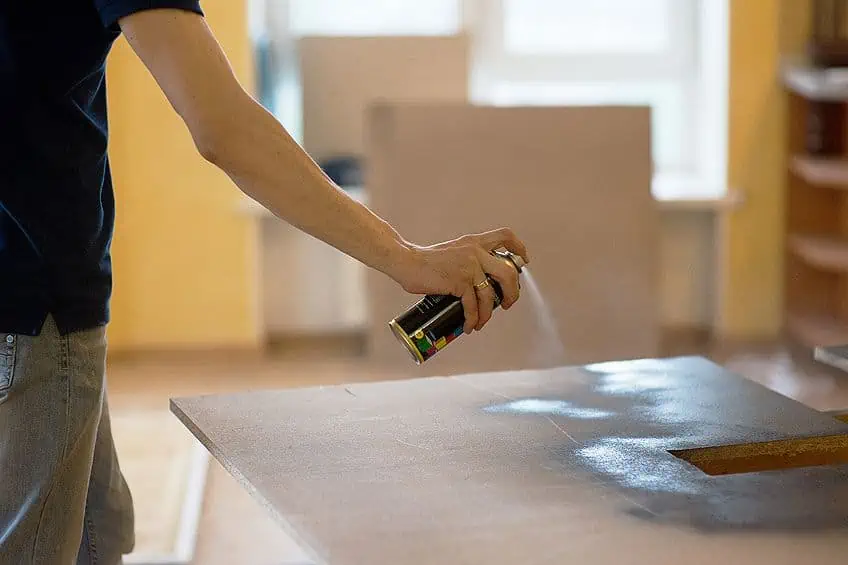
How do you Choose the Right tip for Your Paint Sprayer?
The choice of tip or nozzle for your paint sprayer is determined by what you want to do and what paint you are going to be using. For example, larger surfaces need a larger tip. For more detailed painting, a smaller tip is needed to prevent overspray and provide more precision. Thicker and thinner paint will also need different tips.
Is it Best to Spray Outside or Inside?
Outside would be best, but if you have to paint inside, you should make sure you have excellent ventilation. You can even use a fan if necessary, to keep the paint particles from lingering in the air.
Is it Necessary to Practice Spray Painting?
Yes, this is a good idea to prevent any mistakes from happening. You can get a feel for the sprayer if it is your first time, and you can make necessary adjustments before spraying onto the proper surface. Practicing will also help develop the right painting techniques for a good finish.
Do you Need to Thin Your Paint Before Spraying?
Certain types of paint sprayers can manage thicker paints, like an airless sprayer as it uses a higher pressure. However, an HVLP (High Volume Low Pressure) sprayer cannot manage thicker paints, so they will need to be thinned to work. If you do not thin the paint, it will not spray properly and the only thing that will come out are blobs of paint.
In 2005, Charlene completed her wellness degrees in therapeutic aromatherapy and reflexology at the International School of Reflexology and Meridian Therapy. She worked for a company offering corporate wellness programs for several years before opening her own therapy practice. In 2015, she was asked by a digital marketer friend to join her company as a content creator, and it was here that she discovered her enthusiasm for writing. Since entering the world of content creation, she has gained a lot of experience over the years writing about various topics such as beauty, health, wellness, travel, crafting, and much more. Due to various circumstances, she had to give up her therapy practice and now works as a freelance writer. Since she is a very creative person and as a balance to writing likes to be active in various areas of art and crafts, the activity at acrylgiessen.com is perfect for her to contribute their knowledge and experience in various creative topics.
Learn more about Charlene Lewis and about us.
